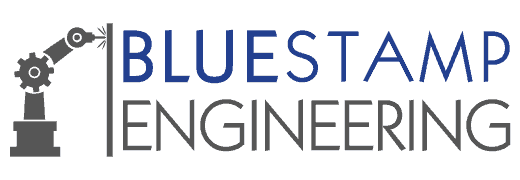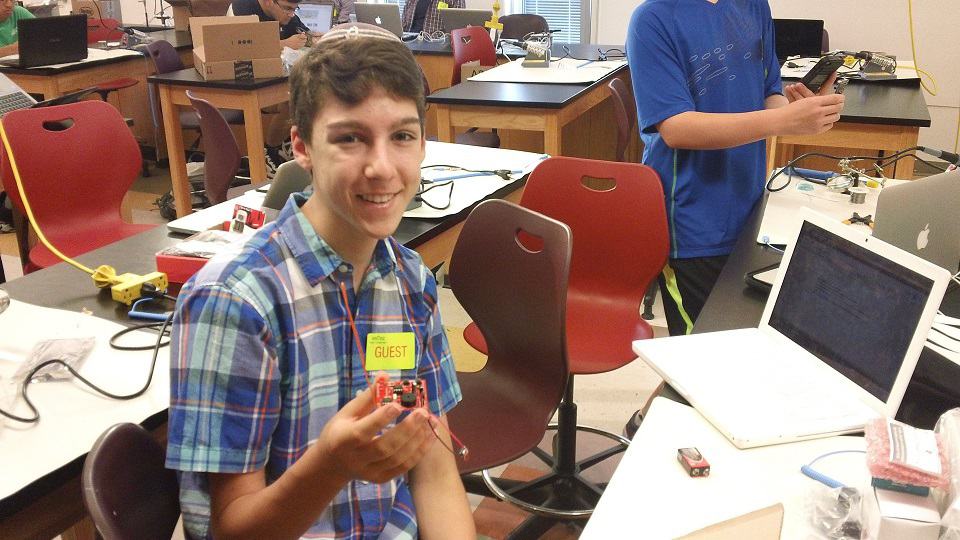Hello! My name is Amiel, and I am a rising Junior at SAR High School. For my starter project, I made an electronic theremin, because I was fascinated by the way it could make music by sensing the proximity of your hand. For my main project, I built a sound and light show, because I had seen large-scale sound and light shows, and I wanted to be able to design and make one by myself, so I could understand how they worked. I have loved BlueStamp, and I would highly recommend it as a summer program, both for the learning and the fun of making your own project and watching it work.
Here are the pictures and the schematic for my final project:
COMPLETED SOUND AND LIGHT SHOW
My sound and light show works by deflecting the beam from a laser diode off of three mirrors attached to motors, onto a wall. Because of persistence of vision, the singular dot of the laser appears to create various shapes on the walls. As the motors spin at different speeds, the shapes on the wall change as well. The system has two different modes, manual and musical, both of which you can access by turning a potentiometer. In manual mode, three potentiometers are used to control each motor. As the potentiometer is rotated farther from the center, an Arduino Leonardo with an Adafruit Motor Shield causes the motors spin faster. The motors are bidirectional, so they can either spin forward or backward, depending on which direction they are turned. In musical mode, you select a song using the same potentiometer that controls the mode, by rotating it to the correct location. Then, there is a button that both starts and resets the song. This song is played by an Arduino Uno connected to an Adafruit Wave Shield, which is connected to a speaker on the same side as the hole through which the laser exits. The sound waves are picked up by a microphone connected to the Leonardo, which then controls the motor speed using the volume of the song. The louder the song is, the faster the motors spin.
Here is my code for the Arduino Leonardo with the Adafruit Motor Shield: CodeforLeonardo
Here is my code for the Arduino Uno with the Adafruit Wave Shield: CodeforUno
COMPLETED LASER LIGHT SHOW
My laser light show works by controlling three motors, each connected to potentiometers, to spin at different speeds and reflect a laser onto a wall. As the motors spin, it creates the illusion of a closed shape, instead of a small dot. The shape appears to morph into various designs, depending on how fast the motors move. I made a code so that when the potentiometers pointed upward, the motors don’t spin. When they are turned to the side, they spin forward or backward, depending on which way they are tilted. There are two switches on the box, one for the power to the whole system, and one for the power to the laser. First, the power is supplied by a 12VDC power supply, fed from an outlet. This then goes through the power switch and to two different places. The first is the Arduino, which can handle the 12V. The second place the electricity goes to is a voltage regulator, which supplies the Adafruit motor shield with 5VDC. The motor shield can’t receive power directly from the Arduino, because the Arduino can’t handle the current that three motors require. The Arduino is linked to the three potentiometers, which are all connected via a breadboard to the 5V and ground on the Arduino. The middle of the potentiometer is attached to the analog inputs on the Arduino. This is where the Arduino receives the input. There are three motors, all connected to the motor shield on top of the Arduino. The laser is connected through a switch to the 5V on the Arduino, allowing it to be switched on and off. Here is my schematic for the whole system (click on it to zoom in):
My code, programmed for Arduino Leonardo is here: CodeforLaserLightShow My materials and locations to find them can be found by following this link: Amiel – Bill of Materials – Sheet My build plan can be found here: BlueStampBuildPlanAmiel
MILESTONE #1
My first milestone is for the potentiometers controlling the rate at which an LED blinks. As I turn the potentiometer, the LED blinks faster. The potentiometer acts as an input to the Arduino, which reads the data inputed and converts it into a number between 0 and 255. The LED, attached to a pin on the Arduino, is told to blink for less and less time as the value gets greater. First, the power is supplied by a 12VDC power supply, fed from an outlet. This then goes through the power switch and to two different places. The first is the Arduino, which can handle the 12V. The second place the electricity goes to is a voltage regulator, which supplies the Adafruit motor shield with 5VDC. The motor shield can’t receive power directly from the Arduino, because the Arduino can’t handle the current that three motors will require when I am done with my project. The Arduino is linked to the three potentiometers, which are all connected via a breadboard to the 5V and ground on the Arduino. The middle of the potentiometer is attached to the analog inputs on the Arduino. This is where the Arduino receives the input. There is a wire connected to a pin on the Arduino, which then attaches to a resistor, then an LED, then back to the ground.
STARTER PROJECT
For my starter project, I built the Junior Theremin, a kit made by ApogeeKits (http://www.apogeekits.com/electronic-kits-intermediate/theremin.htm). The theremin works by creating an electromagnetic field around a wire, then creating sound when your hand disrupts it. The human body has a natural capacitance, which is a measurement of how many electrons you have stored in you. These electrons cause a disturbance in electromagnetic fields, which the theremin detects and translates into different frequencies using a variable oscillator. The electric signal then goes to a piezo, which converts the electricity to sound waves. The theremin has two modes, continuous and discrete. In continuous mode, the theremin makes a continuous sound which varies depending on where your hand is. In discrete mode, each distance is a specific note, but are constant at that distance. The theremin jumps between the notes as you move your hand. Here are the components of the theremin: -The antenna is a wire that broadcasts the electromagnetic field around itself with the help of the variable frequency oscillator. -The variable frequency oscillator emits an electromagnetic field around the antenna. This is a field of electrons that continuously flow between the antenna and the space surrounding it. Since it constantly flows back, it can detect any changes or disruptions. -The piezo converts the signal from the variable oscillator to sound waves that we hear. -The integrated circuit is a series of millions of transistors, all put together for convenience, containing instructions on how the theremin works. -The capacitors store electrical charge to be released at a later point in time. If the circuit needs more or less energy, the capacitor can release or absorb energy, respectively. -The voltage regulator maintains a constant level of voltage so the pieces aren’t exposed to excessive voltage. If it doesn’t work, the theremin will speed up and the sound won’t work properly, since the pieces aren’t exposed to the correct voltage. -The buttons close the circuit when you press them. The left button lowers the octave, the right one raises it. When you press them together, it flips the theremin between continuous mode and discrete mode. -The LEDs, light emitting diodes, allow the current to flow in one direction only and light up when your hand gets closer to the antenna. -The resistors are components that limit the current that flows to the LEDs, so they don’t overheat.








